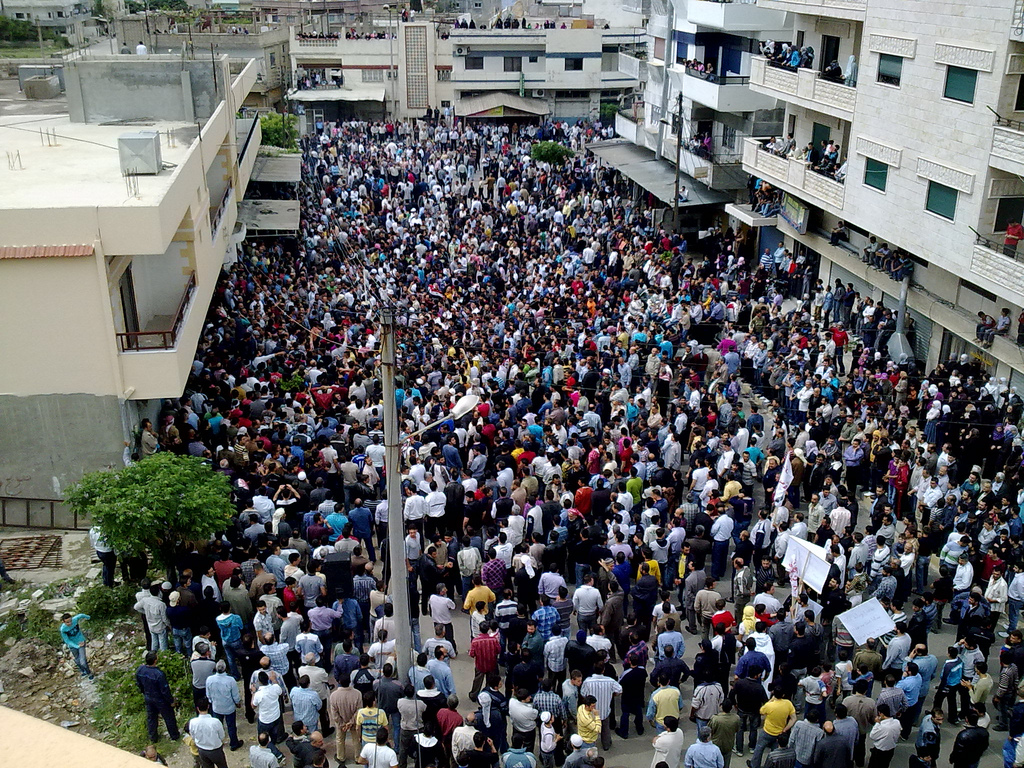By Eian Katz
It has become popular to frame the ongoing protests in Iraq and Lebanon as a revival of the Arab Spring. One thing that the present unrest undoubtedly shares in common with its 2011 progenitor is its expansive geographic span, a characteristic that differentiates it from previous episodes concentrated in capital cities alone. While Baghdad’s Tahrir Square has emerged as the epicenter of the protests in Iraq, small and mid-sized cities across the center and south have been just as turbulent. Likewise, the civil demonstrations in Lebanon stand out among similar actions in recent years for their trans-national scope.
A tour of the region reveals ample precedent for the revolutionary fervor currently gripping even the fringe provinces of Iraq and Lebanon. In fact, beginning with Mohamed Bouazizi’s self-immolation in Tunisia’s Sidi Bouzid governorate, several of the defining episodes of the Arab Spring (in both its 2011 and 2019 incarnations) originated in far-flung outposts and forgotten townships deep in the periphery. In Syria, protests first erupted after the arrest of youths for vandalism in Daraa, an agricultural powerhouse nestled along the Jordanian border. Similarly, Omar al-Bashir’s downfall in Sudan began in earnest with bread riots in Atbara, a blue-collar labor stronghold distinguished by its railway junction and cement factories. The birthplace of Algeria’s continuing revolution (and its mid-20th century colonial liberation movement, too), meanwhile, lies in the country’s northeast, a region home to the historically marginalized Kabyle and Chaoui Berber peoples. Tunisians, Syrians, Sudanese, and Algerians commonly refer to each of these locales as the “cradles” of their respective revolutions.
In each case, the center soon took notice of the periphery’s dissension and drew inspiration from it. Interactive maps charting the pathways by which the uprisings progressed from outside-in are available here for Tunisia, Syria, Sudan, and Algeria. As the action and momentum shifted to the urban core during these democratic upheavals, the periphery receded from prominence. But its starring role in the opening scenes of the counter-authoritarian Arab awakening across several different stages is nonetheless a striking phenomenon both for what it reveals about Arab society and for the challenges it presents to conventional theories on revolution.
When the Cradles Rock
One might be justified in registering surprise at the parochial origins of some of the most momentous social movements in recent Arab history. Political science research indicates a correlation between population size and the factors associated with revolutionary activity. In bigger crowds, the state must act more forcefully to suppress insurrection, leading to more repressive conditions and, in consequence, greater public resentment. Opposition groups operating in these environments have an easier time attracting and mobilizing supporters. The heavier media presence lends them increased visibility and clout. And large populations are characterized by greater heterogeneity, featuring diverse factions that compete with one another for political dominance.
Apart from its population density, the center is often differentiated from the periphery by class, a critical ingredient in revolution. As political scientist Jack Goldstone writes, while peasants and workers serve as the “foot soldiers” of revolution, the ranks of the commanding officers are usually occupied by an urban “vanguard of middle class and professionals.” Major metropolises are also often home to university campuses, the breeding grounds of radical thought and a restive intelligentsia. In many Arab capitals, class strife is amplified further by a labor market that cannot match the supply nor the qualifications of its young, educated workforce. And despite the democratizing effect of social media on political expression and awareness today, a certain level of bourgeois communications acumen and technical aptitude is necessary to orchestrate mass movements.
A capital city would seem to be an especially appropriate site from which to launch a revolution. As the seat of government, it is where demonstrators’ grievances might be most likely to reach the ear of lawmakers. From bureaucrats to government contractors to civil society activists, the capital also boasts a population keenly attuned to political developments and familiar with the state’s inner workings. Moreover, it is where the state is most visible, its abiding presence in daily life virtually inescapable. Capital cityscapes are dotted with federal office buildings and national symbols, all of which are ready-made podiums for savvy protestors.
With all of these conditions favoring political and commercial centers as the axis of revolution, it seems counterintuitive that ground zero for many recent Arab uprisings should be far-removed from these focal points. Several explanations for this phenomenon are available, including causes linked to economics, politics, and security. Perhaps most compelling of these is the pronounced wealth disparity between the core and the periphery in the Middle East and North Africa region. As with Bouazizi himself, revolutions from Algeria to Iraq have been driven at least as much by the economic neglect epitomized in the urban-rural gap as by political overreach.
The core and periphery often differ politically, too, a dissonance that has been demonstrated to be a strong predictor of revolutions. With modernization proceeding at a slower pace in rural locales, traditional norms and conservative political leanings are more likely to prevail. The dissonance is heightened by the strength of tribal identities in the periphery and the presence of ethnic minorities. In authoritarian systems, the regime’s uneven distribution of dividends can create an additional misalignment of interests along regional lines. Dictatorial regimes cultivate support in the center through vast patronage networks, surrounding themselves with crony capitalists and faithful generals. Corruption aside, MENA states are characterized by bloated state payrolls and massive welfare programs, rents that residents of the countryside are less likely to reap. Without the same incentives, rural citizens are less likely to be invested in the state-building project.
A consequence of the high degree of state centralization in the MENA region is that power is concentrated in the core and wanes as it emanates outward. As a result, the periphery tends to be more exposed to security threats, ranging in kind from terror cells to insurgencies to cross-border smuggling. By the same token, the state is less able to exert its control over the further reaches of its territory. While dissent may be controlled in the urban center, the absence of the state in peripheral tinderboxes weakens law and order, undermines the social contract, and erodes nationalist self-identification.
A Peripheral Spark, a Central Flame
Borrowing from the work of Samuel P. Huntington, Goldstone distinguishes between two forms of revolution. In “peripheral revolutions,” urban backing for the government necessitates that “popular mobilization [ ] take place from a secure, often remote, base.” From there, the movement builds popular support in the outskirts, ultimately inducing urban elites to defect and enabling it to enter the capital. Goldstone places revolutions in Afghanistan, Cuba, and Vietnam in this category. In contrast, “central revolutions” proceed by an inverse trajectory, beginning with an elite-fomented or -tolerated challenge to the central regime that precipitates its demise. After the core’s collapse, the revolution must be transported to the periphery, often by force. Think of France, Iran, and Russia.
The cases of Algeria, Sudan, Syria, and Tunisia do not fit neatly into either of these two paradigms. Instead, they represent a hybrid mechanism in which the urban middle class is not necessarily supportive of the regime, but unable to mobilize against it until it can rally behind a roiling periphery. Witness the failure of Syria’s first “day of rage” in Damascus, or the SPA’s aborted march for a higher minimum wage in Khartoum in December 2018. By the same token, spontaneous rural protests focused on discrete issues (such as bread and fuel prices, electricity outages, or political prisoners) do not portend regime change until urban professionals take charge of messaging and organizing. The involvement of trade unions was critical to the success of the uprisings in Sudan and Tunisia; social media brought the crowds to Algiers and Damascus.
Thus, while on one hand, these case studies bespeak a pronounced rift between the core and the periphery, they on the other hand reveal a unity of interest and a co-dependency in action. More than anything, these examples illustrate a two-front failure of the state to integrate critical segments of society, leaving them ripe for rebellion. As Huntington observed, “[a] society is… vulnerable to revolution only when the opposition of the middle class to the political system coincides with the opposition of the peasants.” Tyranny breeds hostility in core and periphery alike, but effective expressions of resistance require coordinated action between the two elements. The middle class’s ability to initiate revolution without joining a rural coalition is limited by the regime’s tight grip over the center and a critical mass of urban elites closely tethered to it. Meanwhile, structural imbalances confine the scope of provincial protest movements until they are able to recruit allies in the center. The lesson for dissidents in either sphere is that they can increase their odds of success by collaborating with their natural partners in the opposite sector.
Eian Katz is Assistant Counsel at Public International Law and Policy Group. Opinions expressed here are his own.





